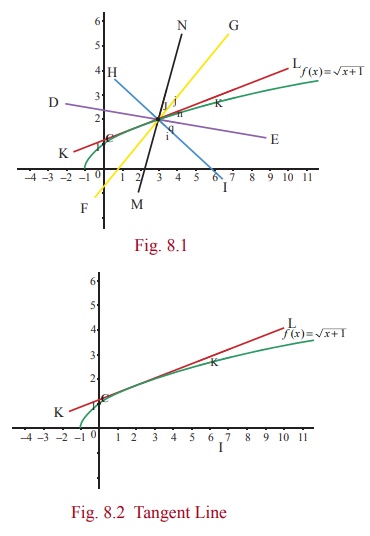Mathematics - Differentials and Partial Derivatives | 12th Maths : UNIT 8 : Differentials and Partial Derivatives
Chapter: 12th Maths : UNIT 8 : Differentials and Partial Derivatives
Differentials and Partial Derivatives
Differentials
and Partial Derivatives
Introduction
Motivation
In real
life we have to deal with many functions. Many times we have to estimate the
change in the function due to change in the independent variable. Here are some
real life situations.
ŌĆó Suppose
that a thin circular metal plate is heated uniformly. Then itŌĆÖs radius
increases and hence its area also increases. Suppose we can measure the
approximate increase in the radius. How can we estimate the increase in the
area of a circular plate?
ŌĆó Suppose
water is getting filled in water tank that is in the shape of an inverted right
circular cone. In this process the height of the water level changes, the
radius of the water level changes and the volume of the water in the tank
changes as time changes. In a small interval of time, if we can measure the
change in the height, change in the radius, how can we estimate the change in
the volume of the water in the interval?
ŌĆó A
satellite is launched into the space from a launch pad. A camera is being set
up, to observe the launch, at a safe distance from the launch pad. As the
satellite lifts up, cameraŌĆÖs angle of elevation changes. If we know the two
consecutive angles of elevation, within a small interval of time, how can we
estimate the distance traveled by the satellite during that short interval of
time?
To
address these type of questions, we shall use the ideas of derivatives and
partial derivatives to find linear approximations and differentials of the
functions involved.
In the
earlier chapters we have learnt the concept of derivative of a real-valued
function of a single real variable. We have also learnt its applications in
finding extremum of a function on its domain, and sketching the graph of a
function. In this chapter, we shall see one more application of the derivative in
estimating values of a function at some point. We know that linear functions, y = mx
+ b , are easy to work with; whereas nonlinear functions are computationally a
bit tedious to work with.

For instance, if we have two functions, say f (x) = ŌłÜ( x +1), g(x ) = 2x ŌłÆ 7 and suppose that we want to evaluate these functions at say x = 3.25 . Which one will be easy to evaluate? Obviously, g(3.25) will be easier to calculate than f (3.25) . If we are ready to accept some error in calculating f (3.25) , then we can find a linear function that approximates f near x = 3 and use this linear function to obtain an approximate value of f (3.25) .We know that the graph of a function is a nonvertical line if and only if it is a linear function. Out of infinitely many straight lines passing through any given point on the graph of the function, only tangent line gives a good approximation to the function, because the graph of f looks approximately a straight line on the vicinity of the point (3,2).

From the
figures above it is clear that among these straight lines, only the tangent
line to the graph of f ( x) at x = 3 gives a good approximation near the point x = 3 . Basically we are ŌĆ£linearizingŌĆØ
the given function at a selected point (3, 2) . This idea helps us in
estimating the change in the function value near the chosen point through the
change in the input. We shall use ŌĆ£derivativeŌĆØ to introduce the concept of ŌĆ£differentialŌĆØ
which approximates the change in the function and will also be useful in
calculating approximate values of a function near a chosen point. The
derivative measures the instantaneous rate of change where as the differential
approximates the change in the function values. Also, differentials are useful
later in solving differential equations and evaluating definite integrals by
the substitution method.
After
learning differentials, we will focus on real valued functions of several
variables. For functions of several variables, we shall introduce ŌĆ£partial
derivativesŌĆØ, a generalization of the concept of ŌĆ£derivativeŌĆØ
of real-valued function of one variable. Why should we consider functions of
more than one variable? Let us consider a simple situation that will explain
the need. Suppose that a company is producing say pens and notebooks. This
company is interested in maximizing its profit; then it has to find out the
production level that will give maximum profit. To determine this, it has to
analyze its revenue, cost, and profit functions, which are, in this case, functions
of two variables (pen, notebook). Similarly, if we want to consider the volume
of a box, then it will be a function of three variables namely length, width,
and height. Also, the economy of a country depends on so many sectors and hence
it depends on many variables. Thus it is necessary and important to consider
functions involving more than one variable and develop the ŌĆ£concept of
derivativeŌĆØ for functions of more than one variable. We shall also develop the
concept of ŌĆ£differentialŌĆØ
for functions of two and three variables and consider some of its applications.
In this chapter, we shall consider only real-valued functions.
Learning Objectives
Upon
completion of this chapter, students will be able to
ŌĆó calculate
the linear approximation of a function of one variable at a point
ŌĆó approximate
the value of a function using its linear approximation without calculators
ŌĆó calculate
the differential of a function
ŌĆó apply
linear approximation, differential in problems from real life situations
ŌĆó find
partial derivatives of a function of more than one variable
ŌĆó calculate
the linear approximation of a function of two or more variables
ŌĆó determine
if a given function of several variables is homogeneous or not
ŌĆó apply
EulerŌĆÖs theorem for homogeneous functions.
Related Topics